Github 项目 - tensorflow-yolov3
作者:YunYang1994
论文:yolov3
最近 YunYang1994开源的基于 TensorFlow(TF-Slim) 复现的 YOLOv3 复现,并支持自定义数据集的训练.
该开源项目组成:
- YOLO v3 网络结构
- 权重转换Weights converter (用于将加载的 COCO 权重导出为 TF checkpoint)
- 基础测试 demo
- 支持 GPU 和 CPU 版本的 NMS
- Training pipeline
- 计算 COCO mAP
1. YOLOV3 主要原理
YOLO 目标检测器基于深度卷积网络学习的特征,以检测目标物体.
正如 木盏 博文里的介绍,YOLOV3 对比 YOLOV1 和 YOLOV2,保留的部分有:
[1] - 分而治之, YOLO 系列算法是通过划分单元格进行目标检测,区别只是划分单元格的数量不同.
[2] - 激活函数采用 Leaky ReLU.
[3] - End-to-end 训练,只需一个损失函数,关注网络输入端和输出端.
[4] - YOLOV2 开始,采用 Batch Normalization 作为正则化、加速收敛和避免过拟合的方法,并将 BN 层和 Leaky ReLU 层放在每个卷积层之后.
[5] - 多尺度训练. 平衡速度和准确率,速度快,则准确率相对低;准确率高,则速度相对慢.
YOLO 系列算法的提升,很大一部分也决定于 backbone 网络的提升,如,YOLOV2 的 darknet-19 到 YOLOV3 的 darknet-53. YOLOV3 还提供了 tiny darknet. 速度快,则 backbone 可采用 tiny-darknet;性能好,则 backbone 可采用 darnket-53. YOLO 系列算法比较灵活,特别适合作工程算法.
1.1. 网络结构
该项目里使用了预训练的网络权重,其中,共有 80 个训练的 yolo 物体类别(COCO 数据集).
记物体类别名 - coco.names 为 c,其是从 1 到 80 的整数,每个数字分别表示对应的类别名标签. 如,c=3 表示的分类物体类别为 cat.
深度卷积层学习的图像特征,送入到分类器和回归器中,以进行检测预测.(边界框坐标,对应的类别标签,等).
如图:
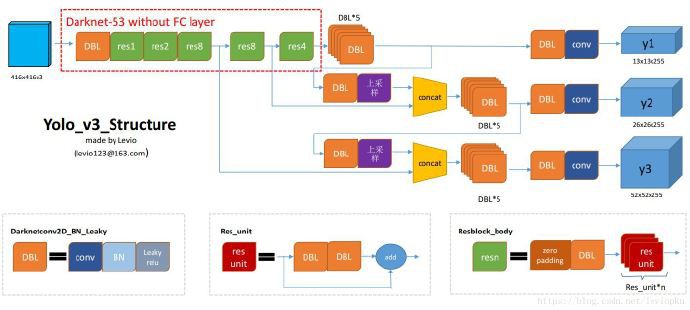
From yolo系列之yolo v3【深度解析】- 木盏 - CSDN
YOLOV3 结构中,没有 池化层 和 全连接层. 在网络的前向计算过程中,张量的尺寸变换是通过改变卷积核步长来实现的,如:stride=(2, 2),等价于将图像 width 和 height 均缩小一般(即面积缩小到原来的1/4).
而,YOLOV2 中,要进行 5 次张量尺寸的缩小(MaxPool),特征图会缩小到原输入尺寸的 在yolo_v2中,要经历5次缩小,会将特征图缩小到原输入尺寸的 $1/2^5$,即1/32. 例如,输入图像尺寸为 416x416,则输出特征图尺寸为 13x13 (416/32=13).
YOLOV3 类似于 YOLOV2,backbone 网络会将输出特征图缩小到输入图片的 1/32. 因此,要求输入图片的尺寸为 32 的倍数.
- DBL: YOLOV3 的基本组件,对应于代码中的Darknetconv2d_BN_Leaky,即:卷积+BN+Leaky relu. YOLOV3 中 BN 和 Leaky ReLU 和卷积层是不可分类的部分(除了最后一层卷积),共同构成了最小组件.
- resn:
n代表数字,表示 res_block 里有多少个 res_unit,如 res1,res2, … , res8 等. YOLOV3 借鉴了 ResNet 的残差结构,可以使得网络更深. - concat:张量拼接操作. 将 darknet 中间层和后面的某一层的上采样进行拼接. 拼接操作和残差层 add 操作是不一样的,拼接会扩充张量的维度,而 add 只是直接相加不会导致张量维度的改变.
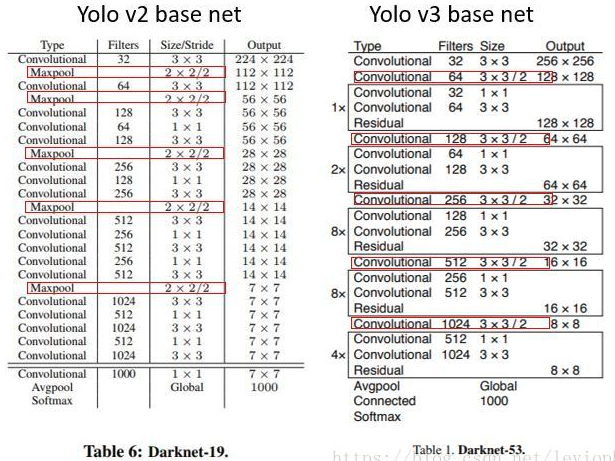
Darknet-19 vs Darknet-53 网络层结构 (From yolo系列之yolo v3【深度解析】- 木盏 - CSDN)
YOLOV3 输出了三个不同尺度的特征图 - y1, y2, y3,如图:

这种多尺度预测方式,借鉴了 FPN(Feature pyramid networks),对不同尺寸的目标进行预测,越精细的单元网格( grid cell) 可以检测出越精细的物体.
YOLOV3 设定每个网格单元输出 3 个矩形框box 的预测,每个 box 需要五个参数(x, y, w, h, confidence),再对应 80 个类别的概率,则可得到 3*(5 + 80) = 255.
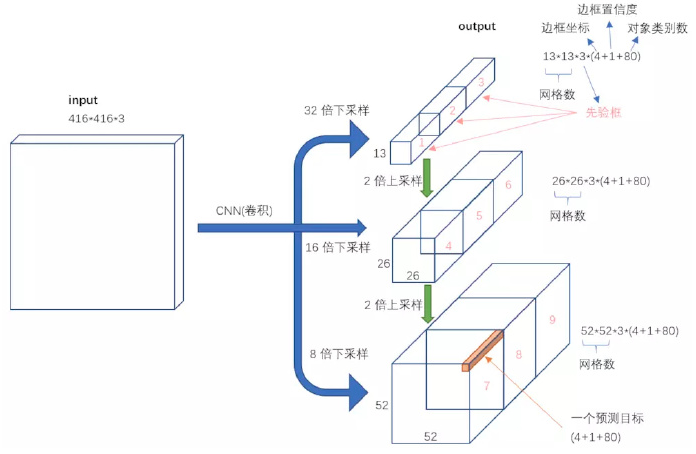
From YOLOv3代码分析(Keras+Tensorflow)
1.2. 网络输入与输出
[1] - 网络输入:[None, 416, 416, 3]
[2] - 网络输出:矩形框中物体的置信度,矩形框位置的列表,检测到的物体类别名. 每个矩形框表示为 6 个数:(Rx, Ry, Rh, Rw, Pc, C1,...Cn). 其中,n=80,即 c 是 80 维向量. 矩形框最终的向量大小为 5 + 80=85. 如图:

图中第一个数字 Pc 为物体的置信;第二个到第四个数字数字 bx, by, bh, bw 表示矩形框坐标信息;最后的 80 个数字中每个分别表示对应于类别的输出概率.
1.3. 设置 score 阈值过滤边界框
输出结果可能包含多个矩形框,可能是 false positive 结果,或者重叠情况. 如,输入图像尺寸为 [416, 416, 3],YOLOV3 总共采用 9 个 anchor boxes(每个尺寸对应 3 个anchor boxes),则可以得到 (52x52 + 26x26 + 13x13)x3=10647 个矩形框.
因此,需要减少输出结果中的矩形框数量,比如,通过设置 score 阈值.
输入参数:
boxes: tensor of shape [10647, 4)]scores: tensor of shape[10647, 80]containing the detection scores for 80 classes.score_thresh: float value , fliter boxes with low score
如:
# Step 1: Create a filtering mask based on "box_class_scores" by using "threshold".
score_thresh=0.4
mask = tf.greater_equal(scores, tf.constant(score_thresh))1.4. NMS 处理
设置 score 阈值过滤预测的矩形框后,还是可能有大量的重叠矩形框. 进一步的操作是,采用 NMS(non-maximum suppression) 算法.
- Discard all boxes with
Pc <= 0.4 While there are any remaining boxes :
- Pick the box with the largest
Pc - Output that as a prediction
- Discard any remaining boxes with
IOU>=0.5with the box output in the previous step
- Pick the box with the largest
如:
for i in range(num_classes):
tf.image.non_max_suppression(boxes, score[:,i], iou_threshold=0.5) NMS 采用了 IoU(Intersection over Union) 函数. NMS 例示如图:NMS 的输入是 4 个重叠的矩形框,输出是只有一个矩形框.
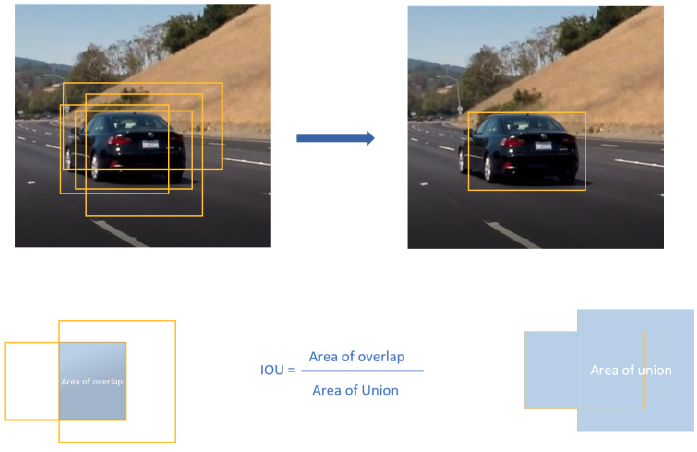
1.5. 相关材料
[1] - Implementing YOLO v3 in Tensorflow (TF-Slim)
[2] - Object Detection using YOLOv2 on Pascal VOC2012
[3] - Understanding YOLO
[4] - YOLOv3目标检测有了TensorFlow实现,可用自己的数据来训练
[5] - 学员分享 | 小哥哥和用YOLOv3做目标检测的故事「文末送课」
[6] - 目标检测|YOLOv2原理与实现(附YOLOv3)
[7] - YOLOv2は、2016年12月25日時点の、速度、精度ともに世界最高のリアルタイム物体検出手法です
2. YOLOV3 项目入手
[1] - 下载项目:
git clone https://github.com/YunYang1994/tensorflow-yolov3.git[2] - 安装项目依赖项:
cd tensorflow-yolov3
pip3 install -r ./docs/requirements.txtrequirements.txt:
numpy==1.15.1
Pillow==5.3.0
scipy==1.1.0
tensorflow-gpu==1.11.0
wget==3.2[3] - 将加载的 COCO 权重导出为 TF Checkpoint - yolov3.ckpt 和 frozen graph - yolov3_gpu_nms.pb.
下载 yolov3.weight,并放到 ./checkpoint/ 路径:
wget https://github.com/YunYang1994/tensorflow-yolov3/releases/download/v1.0/yolov3.weights导出权重:
python3 convert_weight.py --convert --freeze[4] - 利用路径 ./checkpoint/ 中的 .pb 文件,运行测试 demo:
python3 nms_demo.py
python3 video_demo.py # if use camera, set video_path = 0如:
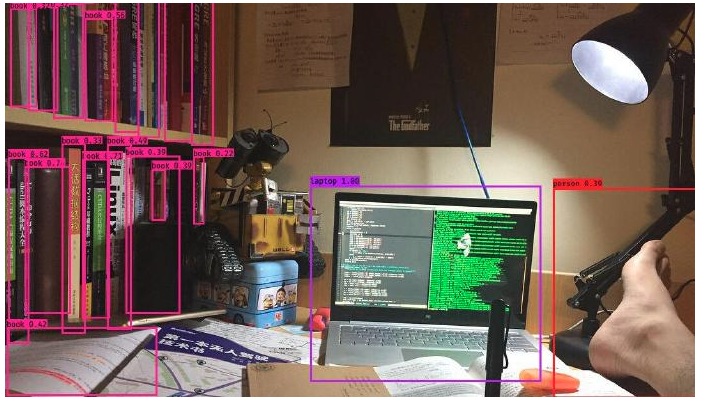
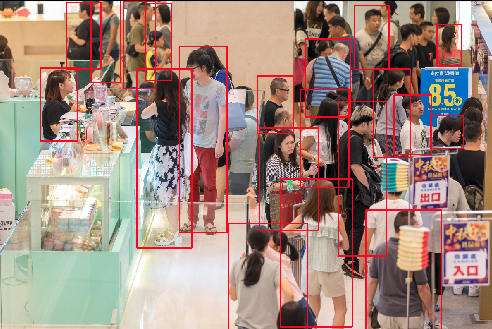
3. YOLOV3 训练
3.1. 下载预训练权重文件
YOLOV3 使用在Imagenet上预训练好的模型参数(文件名称: darknet53.conv.74,大小76MB)基础上继续训练.
darknet53.conv.74下载链接: https://pjreddie.com/media/files/darknet53.conv.74.
wget https://pjreddie.com/media/files/darknet53.conv.743.2. 快速入手训练
这里给出 YOLOV3 训练过程的简单示例.
采用 python3 core/convert_tfrecord.py 将图片数据集转换为 tfrecords 文件.
python3 core/convert_tfrecord.py \
--dataset /data/train_data/quick_train_data/quick_train_data.txt \
--tfrecord_path_prefix /data/train_data/quick_train_data/tfrecords/quick_train_data
python3 quick_train.py # start training3.3. 训练 COCO 数据集
[1] - 首先,需要下载 COCO2017 数据集,并放到路径 ./data/train_data/COCO 中.
cd data/train_data/COCO
wget http://images.cocodataset.org/zips/train2017.zip
unzip train2017.zip
wget http://images.cocodataset.org/annotations/annotations_trainval2017.zip
unzip annotations_trainval2017.zip[2] - 提取 COCO 数据集中的一些有用信息,如边界框(bounding box), category id 等,并生成 .txt 文件.
python3 core/extract_coco.py --dataset_info_path ./data/train_data/COCO/train2017.txt即可得到 ./data/train_data/COCO/train2017.txt. 每一行为一个样本,如:
/path/to/data/train_data/train2017/000000458533.jpg 20 18.19 6.32 424.13 421.83 20 323.86 2.65 640.0 421.94
/path/to/data/train_data/train2017/000000514915.jpg 16 55.38 132.63 519.84 380.4
# image_path, category_id, x_min, y_min, x_max, y_max, category_id, x_min, y_min, ...[3] - 接着,将图像数据集转换为 .tfrecord 数据集,以二进制文件的方式存储数据. 之后,即可进行模型训练.
python3 core/convert_tfrecord.py \
--dataset ./data/train_data/COCO/train2017.txt \
--tfrecord_path_prefix ./data/train_data/COCO/tfrecords/coco \
--num_tfrecords 100
python3 train.py以 YOLOV2 的训练过程为例:
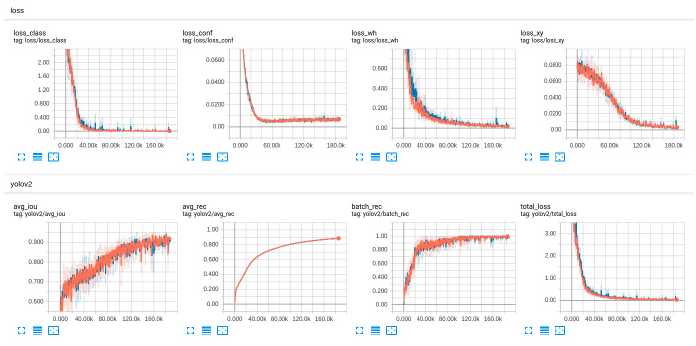
3.4. 在 COCO 数据集上的评估验证(待续)
cd data/train_data/COCO
wget http://images.cocodataset.org/zips/test2017.zip
wget http://images.cocodataset.org/annotations/image_info_test2017.zip
unzip test2017.zip
unzip image_info_test2017.zip4. YOLOV3 模型定义
#! /usr/bin/env python3
# coding=utf-8
#================================================================
# Copyright (C) 2018 * Ltd. All rights reserved.
#
# Editor : VIM
# File name : common.py
# Author : YunYang1994
# Created date: 2018-11-20 10:22:32
# Description : some basical layer for daraknet53 and yolov3
#
#================================================================
import tensorflow as tf
slim = tf.contrib.slim
def _conv2d_fixed_padding(inputs, filters, kernel_size, strides=1):
if strides > 1: inputs = _fixed_padding(inputs, kernel_size)
inputs = slim.conv2d(inputs, filters, kernel_size, stride=strides,
padding=('SAME' if strides == 1 else 'VALID'))
return inputs
@tf.contrib.framework.add_arg_scope
def _fixed_padding(inputs, kernel_size, *args, mode='CONSTANT', **kwargs):
"""
Pads the input along the spatial dimensions independently of input size.
Args:
inputs: A tensor of size [batch, channels, height_in, width_in] or
[batch, height_in, width_in, channels] depending on data_format.
kernel_size: The kernel to be used in the conv2d or max_pool2d operation.
Should be a positive integer.
mode: The mode for tf.pad.
Returns:
A tensor with the same format as the input with the data either intact
(if kernel_size == 1) or padded (if kernel_size > 1).
"""
pad_total = kernel_size - 1
pad_beg = pad_total // 2
pad_end = pad_total - pad_beg
padded_inputs = tf.pad(inputs, [[0, 0], [pad_beg, pad_end],
[pad_beg, pad_end], [0, 0]],
mode=mode)
return padded_inputs#! /usr/bin/env python3
# coding=utf-8
#================================================================
# Copyright (C) 2018 * Ltd. All rights reserved.
#
# Editor : VIM
# File name : yolov3.py
# Author : YunYang1994
# Created date: 2018-11-21 18:41:35
# Description : YOLOv3: An Incremental Improvement
#
#================================================================
import numpy as np
import tensorflow as tf
from core import common, utils
slim = tf.contrib.slim
class darknet53(object):
"""network for performing feature extraction"""
def __init__(self, inputs):
self.outputs = self.forward(inputs)
def _darknet53_block(self, inputs, filters):
"""
implement residuals block in darknet53
"""
shortcut = inputs
inputs = common._conv2d_fixed_padding(inputs, filters * 1, 1)
inputs = common._conv2d_fixed_padding(inputs, filters * 2, 3)
inputs = inputs + shortcut
return inputs
def forward(self, inputs):
inputs = common._conv2d_fixed_padding(inputs, 32, 3, strides=1)
inputs = common._conv2d_fixed_padding(inputs, 64, 3, strides=2)
inputs = self._darknet53_block(inputs, 32)
inputs = common._conv2d_fixed_padding(inputs, 128, 3, strides=2)
for i in range(2):
inputs = self._darknet53_block(inputs, 64)
inputs = common._conv2d_fixed_padding(inputs, 256, 3, strides=2)
for i in range(8):
inputs = self._darknet53_block(inputs, 128)
route_1 = inputs
inputs = common._conv2d_fixed_padding(inputs, 512, 3, strides=2)
for i in range(8):
inputs = self._darknet53_block(inputs, 256)
route_2 = inputs
inputs = common._conv2d_fixed_padding(inputs, 1024, 3, strides=2)
for i in range(4):
inputs = self._darknet53_block(inputs, 512)
return route_1, route_2, inputs
class yolov3(object):
def __init__(self, num_classes=80,
batch_norm_decay=0.9,
leaky_relu=0.1,
anchors_path='./data/yolo_anchors.txt'):
# self._ANCHORS = [[10 ,13], [16 , 30], [33 , 23],
# [30 ,61], [62 , 45], [59 ,119],
# [116,90], [156,198], [373,326]]
self._ANCHORS = utils.get_anchors(anchors_path)
self._BATCH_NORM_DECAY = batch_norm_decay
self._LEAKY_RELU = leaky_relu
self._NUM_CLASSES = num_classes
self.feature_maps = [] # [[None, 13, 13, 255],
# [None, 26, 26, 255],
# [None, 52, 52, 255]]
def _yolo_block(self, inputs, filters):
inputs = common._conv2d_fixed_padding(inputs, filters * 1, 1)
inputs = common._conv2d_fixed_padding(inputs, filters * 2, 3)
inputs = common._conv2d_fixed_padding(inputs, filters * 1, 1)
inputs = common._conv2d_fixed_padding(inputs, filters * 2, 3)
inputs = common._conv2d_fixed_padding(inputs, filters * 1, 1)
route = inputs
inputs = common._conv2d_fixed_padding(inputs, filters * 2, 3)
return route, inputs
def _detection_layer(self, inputs, anchors):
num_anchors = len(anchors)
feature_map = slim.conv2d(inputs,
num_anchors * (5 + self._NUM_CLASSES),
1,
stride=1,
normalizer_fn=None,
activation_fn=None,
biases_initializer=tf.zeros_initializer())
return feature_map
def _reorg_layer(self, feature_map, anchors):
num_anchors = len(anchors) # num_anchors=3
grid_size = feature_map.shape.as_list()[1:3]
stride = tf.cast(self.img_size // grid_size, tf.float32)
feature_map = tf.reshape(feature_map,
[-1, grid_size[0], grid_size[1],
num_anchors, 5 + self._NUM_CLASSES])
box_centers, box_sizes, conf_logits, prob_logits = tf.split(
feature_map, [2, 2, 1, self._NUM_CLASSES], axis=-1)
box_centers = tf.nn.sigmoid(box_centers)
grid_x = tf.range(grid_size[0], dtype=tf.int32)
grid_y = tf.range(grid_size[1], dtype=tf.int32)
a, b = tf.meshgrid(grid_x, grid_y)
x_offset = tf.reshape(a, (-1, 1))
y_offset = tf.reshape(b, (-1, 1))
x_y_offset = tf.concat([x_offset, y_offset], axis=-1)
x_y_offset = tf.reshape(x_y_offset, [grid_size[0], grid_size[1], 1, 2])
x_y_offset = tf.cast(x_y_offset, tf.float32)
box_centers = box_centers + x_y_offset
box_centers = box_centers * stride
box_sizes = tf.exp(box_sizes) * anchors
boxes = tf.concat([box_centers, box_sizes], axis=-1)
return x_y_offset, boxes, conf_logits, prob_logits
@staticmethod
def _upsample(inputs, out_shape):
new_height, new_width = out_shape[1], out_shape[2]
inputs = tf.image.resize_nearest_neighbor(inputs, (new_height, new_width))
inputs = tf.identity(inputs, name='upsampled')
return inputs
# @staticmethod
# def _upsample(inputs, out_shape):
# """
# replace resize_nearest_neighbor with conv2d_transpose To support TensorRT 5 optimization
# """
# new_height, new_width = out_shape[1], out_shape[2]
# filters = 256 if (new_height == 26 and new_width==26) else 128
# inputs = tf.layers.conv2d_transpose(inputs,
# filters,
# k
# ernel_size=3,
# padding='same',
# strides=(2,2),
# kernel_initializer=tf.ones_initializer())
# return inputs
def forward(self, inputs, is_training=False, reuse=False):
"""
Creates YOLO v3 model.
:param inputs: a 4-D tensor of size [batch_size, height, width, channels].
Dimension batch_size may be undefined. The channel order is RGB.
:param is_training: whether is training or not.
:param reuse: whether or not the network and its variables should be reused.
:return:
"""
# it will be needed later on
self.img_size = tf.shape(inputs)[1:3]
# set batch norm params
batch_norm_params = {
'decay': self._BATCH_NORM_DECAY,
'epsilon': 1e-05,
'scale': True,
'is_training': is_training,
'fused': None, # Use fused batch norm if possible.
}
# Set activation_fn and parameters for conv2d, batch_norm.
with slim.arg_scope([slim.conv2d, slim.batch_norm, common._fixed_padding],
reuse=reuse):
with slim.arg_scope([slim.conv2d], normalizer_fn=slim.batch_norm,
normalizer_params=batch_norm_params,
biases_initializer=None,
activation_fn=lambda x: tf.nn.leaky_relu(x, alpha=self._LEAKY_RELU)):
with tf.variable_scope('darknet-53'):
route_1, route_2, inputs = darknet53(inputs).outputs
with tf.variable_scope('yolo-v3'):
route, inputs = self._yolo_block(inputs, 512)
feature_map_1 = self._detection_layer(inputs, self._ANCHORS[6:9])
feature_map_1 = tf.identity(feature_map_1, name='feature_map_1')
inputs = common._conv2d_fixed_padding(route, 256, 1)
upsample_size = route_2.get_shape().as_list()
inputs = self._upsample(inputs, upsample_size)
inputs = tf.concat([inputs, route_2], axis=3)
route, inputs = self._yolo_block(inputs, 256)
feature_map_2 = self._detection_layer(inputs, self._ANCHORS[3:6])
feature_map_2 = tf.identity(feature_map_2, name='feature_map_2')
inputs = common._conv2d_fixed_padding(route, 128, 1)
upsample_size = route_1.get_shape().as_list()
inputs = self._upsample(inputs, upsample_size)
inputs = tf.concat([inputs, route_1], axis=3)
route, inputs = self._yolo_block(inputs, 128)
feature_map_3 = self._detection_layer(inputs, self._ANCHORS[0:3])
feature_map_3 = tf.identity(feature_map_3, name='feature_map_3')
return feature_map_1, feature_map_2, feature_map_3
def _reshape(self, x_y_offset, boxes, confs, probs):
grid_size = x_y_offset.shape.as_list()[:2]
boxes = tf.reshape(boxes, [-1, grid_size[0]*grid_size[1]*3, 4])
confs = tf.reshape(confs, [-1, grid_size[0]*grid_size[1]*3, 1])
probs = tf.reshape(probs, [-1, grid_size[0]*grid_size[1]*3, self._NUM_CLASSES])
return boxes, confs, probs
def predict(self, feature_maps):
"""
Note: given by feature_maps, compute the receptive field
and get boxes, confs and class_probs
input_argument: feature_maps -> [None, 13, 13, 255],
[None, 26, 26, 255],
[None, 52, 52, 255],
"""
feature_map_1, feature_map_2, feature_map_3 = feature_maps
feature_map_anchors = [(feature_map_1, self._ANCHORS[6:9]),
(feature_map_2, self._ANCHORS[3:6]),
(feature_map_3, self._ANCHORS[0:3]),]
results = [self._reorg_layer(feature_map, anchors) for (feature_map, anchors) in feature_map_anchors]
boxes_list, confs_list, probs_list = [], [], []
for result in results:
boxes, conf_logits, prob_logits = self._reshape(*result)
confs = tf.sigmoid(conf_logits)
probs = tf.sigmoid(prob_logits)
boxes_list.append(boxes)
confs_list.append(confs)
probs_list.append(probs)
boxes = tf.concat(boxes_list, axis=1)
confs = tf.concat(confs_list, axis=1)
probs = tf.concat(probs_list, axis=1)
center_x, center_y, height, width = tf.split(boxes, [1,1,1,1], axis=-1)
x0 = center_x - height / 2
y0 = center_y - width / 2
x1 = center_x + height / 2
y1 = center_y + width / 2
boxes = tf.concat([x0, y0, x1, y1], axis=-1)
return boxes, confs, probs
def compute_loss(self, y_pred, y_true, ignore_thresh=0.5, max_box_per_image=8):
"""
Note: compute the loss
Arguments: y_pred, list -> [feature_map_1, feature_map_2, feature_map_3]
the shape of [None, 13, 13, 3*85]. etc
"""
loss_xy, loss_wh, loss_conf, loss_class = 0., 0., 0., 0.
total_loss, rec_50, rec_75, avg_iou = 0., 0., 0., 0.
_ANCHORS = [self._ANCHORS[6:9], self._ANCHORS[3:6], self._ANCHORS[0:3]]
for i in range(len( y_pred )):
result = self.loss_layer(y_pred[i], y_true[i], _ANCHORS[i], ignore_thresh, max_box_per_image)
loss_xy += result[0]
loss_wh += result[1]
loss_conf += result[2]
loss_class += result[3]
rec_50 += result[4]
rec_75 += result[5]
avg_iou += result[6]
total_loss = loss_xy + loss_wh + loss_conf + loss_class
return [total_loss, loss_xy, loss_wh, loss_conf, loss_class, rec_50, rec_75, avg_iou]
def loss_layer(self, feature_map_i, y_true, anchors, ignore_thresh, max_box_per_image):
NO_OBJECT_SCALE = 1.0
OBJECT_SCALE = 5.0
COORD_SCALE = 1.0
CLASS_SCALE = 1.0
grid_size = tf.shape(feature_map_i)[1:3] # [13, 13]
stride = tf.cast(self.img_size//grid_size, dtype=tf.float32) # [32, 32]
pred_result = self._reorg_layer(feature_map_i, anchors)
xy_offset, pred_boxes, pred_box_conf_logits, pred_box_class_logits = pred_result
# (13, 13, 1, 2), (1, 13, 13, 3, 4), (1, 13, 13, 3, 1), (1, 13, 13, 3, 80)
# pred_boxes 前面两个坐标是左上角,后面两个是右下角
"""
Adjust prediction
"""
pred_box_conf = tf.nn.sigmoid(pred_box_conf_logits) # adjust confidence
pred_box_class = tf.argmax(tf.nn.softmax(pred_box_class_logits), -1) # adjust class probabilities
pred_box_xy = (pred_boxes[..., 0:2] + pred_boxes[..., 2:4]) / 2. # absolute coordinate
pred_box_wh = pred_boxes[..., 2:4] - pred_boxes[..., 0:2] # absolute size
# 每个cell里都会预测一个boundingbox,y_true里面每个cell里也对应一个
# boundingbox,那么怎么计算iou呢?
"""
Adjust ground truth
"""
true_box_class = tf.argmax(y_true[..., 5:], -1)
true_box_conf = y_true[..., 4:5]
true_box_xy = y_true[..., 0:2] # absolute coordinate
true_box_wh = y_true[..., 2:4] # absolute size
object_mask = y_true[..., 4:5]
# initially, drag all objectness of all boxes to 0
conf_delta = pred_box_conf - 0
"""
Compute some online statistics
"""
true_mins = true_box_xy - true_box_wh / 2.
true_maxs = true_box_xy + true_box_wh / 2.
pred_mins = pred_box_xy - pred_box_wh / 2.
pred_maxs = pred_box_xy + pred_box_wh / 2.
intersect_mins = tf.maximum(pred_mins, true_mins)
intersect_maxs = tf.minimum(pred_maxs, true_maxs)
intersect_wh = tf.maximum(intersect_maxs - intersect_mins, 0.)
intersect_area = intersect_wh[..., 0] * intersect_wh[..., 1]
true_area = true_box_wh[..., 0] * true_box_wh[..., 1]
pred_area = pred_box_wh[..., 0] * pred_box_wh[..., 1]
union_area = pred_area + true_area - intersect_area
iou_scores = tf.truediv(intersect_area, union_area)
return object_mask, intersect_area, iou_scores
iou_scores = object_mask * tf.expand_dims(iou_scores, 4)
count = tf.reduce_sum(object_mask)
detect_mask = tf.to_float((pred_box_conf*object_mask) >= 0.5)
class_mask = tf.expand_dims(tf.to_float(tf.equal(pred_box_class, true_box_class)), 4)
recall50 = tf.reduce_mean(tf.to_float(iou_scores >= 0.5 ) * detect_mask * class_mask) / (count + 1e-3)
recall75 = tf.reduce_mean(tf.to_float(iou_scores >= 0.75) * detect_mask * class_mask) / (count + 1e-3)
avg_iou = tf.reduce_mean(iou_scores) / (count + 1e-3)
"""
Compare each predicted box to all true boxes
"""
def pick_out_gt_box(y_true):
y_true = y_true.copy()
bs = y_true.shape[0]
# print("=>y_true", y_true.shape)
true_boxes_batch = np.zeros([bs, 1, 1, 1, max_box_per_image, 4], dtype=np.float32)
# print("=>true_boxes_batch", true_boxes_batch.shape)
for i in range(bs):
y_true_per_layer = y_true[i]
true_boxes_per_layer = y_true_per_layer[y_true_per_layer[..., 4] > 0][:, 0:4]
if len(true_boxes_per_layer) == 0: continue
true_boxes_batch[i][0][0][0][0:len(true_boxes_per_layer)] = true_boxes_per_layer
return true_boxes_batch
true_boxes = tf.py_func(pick_out_gt_box, [y_true], [tf.float32] )[0]
true_xy = true_boxes[..., 0:2] # absolute location
true_wh = true_boxes[..., 2:4] # absolute size
true_mins = true_xy - true_wh / 2.
true_maxs = true_xy + true_wh / 2.
pred_mins = tf.expand_dims(pred_boxes[..., 0:2], axis=4)
pred_maxs = tf.expand_dims(pred_boxes[..., 2:4], axis=4)
pred_wh = pred_maxs - pred_mins
intersect_mins = tf.maximum(pred_mins, true_mins)
intersect_maxs = tf.minimum(pred_maxs, true_maxs)
intersect_wh = tf.maximum(intersect_maxs - intersect_mins, 0.)
intersect_area = intersect_wh[..., 0] * intersect_wh[..., 1]
true_area = true_wh[..., 0] * true_wh[..., 1]
pred_area = pred_wh[..., 0] * pred_wh[..., 1]
union_area = pred_area + true_area - intersect_area
iou_scores = tf.truediv(intersect_area, union_area)
best_ious = tf.reduce_max(iou_scores, axis=4)
conf_delta *= tf.expand_dims(tf.to_float(best_ious < ignore_thresh), 4)
"""
Compare each true box to all anchor boxes
"""
### adjust x and y => relative position to the containing cell
true_box_xy = true_box_xy / stride - xy_offset # t_xy in `sigma(t_xy) + c_xy`
pred_box_xy = pred_box_xy / stride - xy_offset
### adjust w and h => relative size to the containing cell
true_box_wh_logit = true_box_wh / anchors
pred_box_wh_logit = pred_box_wh / anchors
true_box_wh_logit = tf.where(condition=tf.equal(true_box_wh_logit,0),
x=tf.ones_like(true_box_wh_logit), y=true_box_wh_logit)
pred_box_wh_logit = tf.where(condition=tf.equal(pred_box_wh_logit,0),
x=tf.ones_like(pred_box_wh_logit), y=pred_box_wh_logit)
true_box_wh = tf.log(true_box_wh_logit) # t_wh in `p_wh*exp(t_wh)`
pred_box_wh = tf.log(pred_box_wh_logit)
wh_scale = tf.exp(true_box_wh) * anchors / tf.to_float(self.img_size)
wh_scale = tf.expand_dims(2 - wh_scale[..., 0] * wh_scale[..., 1], axis=4) # the smaller the box, the bigger the scale
xy_delta = object_mask * (pred_box_xy-true_box_xy) * wh_scale * COORD_SCALE
wh_delta = object_mask * (pred_box_wh-true_box_wh) * wh_scale * COORD_SCALE
conf_delta = object_mask * (pred_box_conf-true_box_conf) * OBJECT_SCALE + (1-object_mask) * conf_delta * NO_OBJECT_SCALE
class_delta = object_mask * \
tf.expand_dims(tf.nn.sparse_softmax_cross_entropy_with_logits(
labels=true_box_class,
logits=pred_box_class_logits),
4) * CLASS_SCALE
loss_xy = tf.reduce_mean(tf.square(xy_delta))
loss_wh = tf.reduce_mean(tf.square(wh_delta))
loss_conf = tf.reduce_mean(tf.square(conf_delta))
loss_class = tf.reduce_mean(class_delta)
return loss_xy, loss_wh, loss_conf, loss_class, recall50, recall75, avg_iou